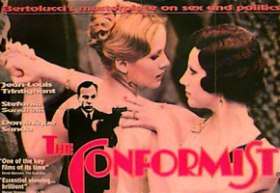The Conformist
A 1970 political thriller, and the 1951 novel of the same name. Second half of the "Kinky Fascist" art-house double feature with Visconti's The Damned.
Set during the era of Mussolini's dictatorship in Italy, Marcello Clerici has spent his life doing everything he can to conform. He marries a pretty, rich girl named Giulia. Unknown to his new wife, Marcello is working for the fascist secret police and is sent on an assignment to kill an outspoken, anti-fascist intellectual now living in France. Marcello is conflicted when he finds out the target he is being sent to kill is his friend and former college professor, Professor Quadri. Marcello travels with Giulia to Paris for thier honeymoon (and to take care of that pesky assasination) but there is another snag in his plan. Marcello falls in love with his target's beautiful wife, Anna. Anna knows Maracello is with the secret police but things are further complicated when she develops feelings for Maracello's wife.
Notable for its beautiful cinematography. Directed by Bernardo Bertolucci with cinematography by Vittorio Storaro
- All Gays Are Pedophiles: Implied by the film (but not the book), considering that the pederast Lino is seen flirting with an adult man. In the book, his attentions are clearly directed only at children.
- Ambiguously Gay: Marcello may or may not be a repressed homosexual. At any rate, he's far more attracted to the masculine-acting Anna than to his more feminine wife.
- Bi the Way: Anna
- Dance of Romance: Marcello's wife Giulia and Quadri's wife Anna.
- Fascist Italy
- Freudian Excuse: Marcello's extreme desire to be normal stems from a childhood incident where he had homosexual encounter with a pedophilic chauffuer and then accidentally shot and killed him. In the end we find out the man is actually still alive, meaning all that Marcello has done in his life to try and make up for the incident was for nothing.
- Heel Face Turn: Not for the right reasons
- Obfuscating Stupidity Giulia acts like a ditz, but she's actually quite clever.
- Rule of Symbolism: Giulia's black and white striped dresses, lighting that creates black and white bars, the bars in the final shot
- Scenery Porn: Makes Paris even more beautiful than it already is.
- Shaggy Dog Story: Mussolini and the fascist Italian government are overthrown in 1943 shortly after the events of the movie. The chauffuer is alive, Marcello did not kill him when he was a child.
- Snow Means Death For Anna and Professor Quadri
- Sympathetic Adulterer: Anna. Less so her book counterpart, Lina.
The Book contains examples of
- Bishonen: In his teenage and adult years, several comments are made about Marcello's good looks and feminine appearance.
- Dark and Troubled Past: Marcello grows up neglected by his parents and bullied by his schoolmates, and is sexually assaulted by Lino at the age of 13. Giulia was continually raped by her "Uncle", 60-year-old lawyer Perpuzzio, from the age of 15.
- Just Following Orders: Near the end of the novel, Orlando wonders how he and Marcello will explain their role in the Fascist government. Even Marcello finds his own answer clichéd.
- Lack of Empathy: Marcello throughout the novel. In particular, when Lina reveals her abuse by Perpuzzio, he knows he should feel upset for her, but he simply can't find the feeling.
- Love Triangle: Marcello is in love with Lina, who is in love with Giulia, who is in love with Marcello, who is . . . er . . .
- Meaningful Name: Lina, the female counterpart of Lino (in more ways than one).
- Mistaken for Gay: Marcello's encounter with the English man.
- Pedophile Priest: Lino is a defrocked priest.
- Sugar and Ice Personality: Lina, depending on whether she's interacting with Giulia or Marcello.
- Taking the Bullet: Lina takes three for Quadri.
